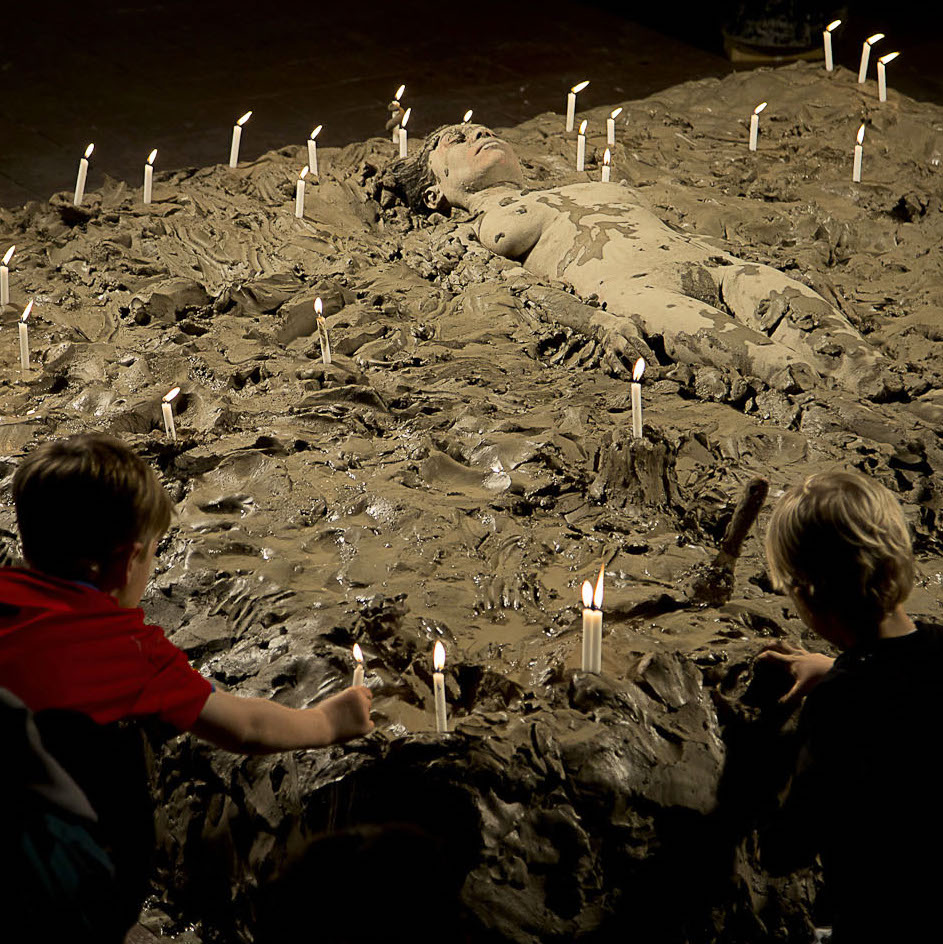We’re wrapping up a busy 2016 with some of our favorite posts of the year. These aren’t necessarily a “best ceramics of the year” list, but rather projects and exhibitions that got our brains firing in new and exciting ways. This piece about time-traveling performance art ran on September 1st. If you haven’t acquainted yourself with being human being please do so now!
COPENHAGEN, Denmark — There’s a metaphor about our place in history. We’re standing in a badly-lit room and there’s a thin, red thread stretched on the floor in front of us. We can see the immediate area around our position, but the thread quickly becomes swallowed in darkness both before and ahead of us. The darkness ahead of us is a given, but it will be revealed in time. More interesting to me is the foggy, murky place where the thread originates. It’s mysterious, romantic and almost certainly dangerous. Even though I can’t follow the string backwards, I’m still tempted to try and place myself there, to imagine what lurks in that poorly-lit place behind.
Above image: From Lilibeth Cuenca Rasmussen, being human being, 2014. Photographs by Frida Nygaard Christensen.
That’s what performance artist Lilibeth Cuenca Rasmussen attempted to do with being human being at Nikolaj Kunsthal (Copenhagen, Oct. 24, 2014 – January 25, 2015). Through seven days of performances that encouraged the public to participate with the artist, Rasmussen tried to project herself into the past to learn (though maybe “understand” is a better word) how our origins affect us today. It stands to reason that some part of the remote past is still with us, even if we cannot immediately recognize it. The museum’s description of the work quickly shows that finding any hard, concrete answers is impossible, but that’s to be expected when the artist’s window looks out on primordial geology leading to the very earliest civilizations. Fans of clay, though, can use their expertise as a way to connect with the work.
The exhibition is based in geology studies of the Earth’s structure and evolution, as we (perhaps) can find some of the answers to the evolution of life here. Even though geology is the natural starting point to the question on the original, geology cannot provide definitive answers to all questions and will there serve only as a basis for the artistic interpretations of origin and function; of the purpose of being.
In Nikolaj Kunsthal Lilibeth Cuenca Rasmussen will mainly focus on her trip to Ethiopia, where traces of the human roots have been found. It is said to be here that the first humans, as we know ourselves, have taken the first step away from a life as great apes into the life of Homo Erectus.
The participatory element was an invitation for others to make this journey with the artist herself. This is exciting because it suggests Rasmussen is, at best, only slightly more knowledgeable about this strange country than her audience is. She’s blinded by the same factors we are, and so she can only provide us with some tools for the journey. This means that any revelations arising from the trip were emergent, unplanned. This approach, though heuristic, was still treated with all the seriousness worthy of the hard sciences. Everything was documented, even if there wasn’t an audience present for the performance. The research happened, whether or not you were there for it. This is from a writeup by Art Territory:
In being human being, the documentation does not only document the events, it is the event. Filming, photographing, and posting installation-updates on social media are part of organizing the exhibition. In contrast to the romantic idea of the artistic genius who creates his work alone, the artworks in being human being are not isolated objects that can be understood apart from their origin. As the artist puts it: “When there weren’t a lot of people, I got insecure about whether we should perform, talk, or produce. But the camera was there all the time, even when the audience didn’t show up.”
For me, the themes are most clear when I read about Rasmussen’s tribute to Lucy, the earliest standing person whose remains were found in Ethiopia. We see Rasmussen laying naked on a bed of wet clay, in a pose that calls to mind statues of knights or saints that adorned old stone sarcophagi. Visitors appeared to have placed tiny candles around Lucy’s body.
What a powerful symbol to use! a way of both respecting the past while acknowledging how painfully little evidence is available to us. Who was Lucy? What was her life like? Did she have children? Was she a decent person by the standards of the time? Did she have mannerisms or quirks of personality that I also have? Do we revere her simply because she’s the earliest fragment of ourselves?
I wasn’t in the room during this performance, but even though Art Territory states that the series lacked something more that would bring all of Rasmussen’s themes home, I imagine that the Lucy exhibition must have been a profound and humbling experience. Even from our privileged point in history, we understand so little, a fact that puts us on even footing with the few fossilized scraps of a person in the collection of the National Museum of Ethiopia.
Neither the hard nor soft sciences will ever fully illuminate the past, but by setting her sights on an impossible goal Rasmussen gives us the next best thing: perspective. Even though we will never know, we can at least try to understand. In the end, that might be better for us, a way to make our trip along this thin, red thread of history a little brighter.
Bill Rodgers is the Managing Editor of cfile.daily.
Do you love or loathe this contemporary ceramic art? Let us know in the comments.









Add your valued opinion to this post.